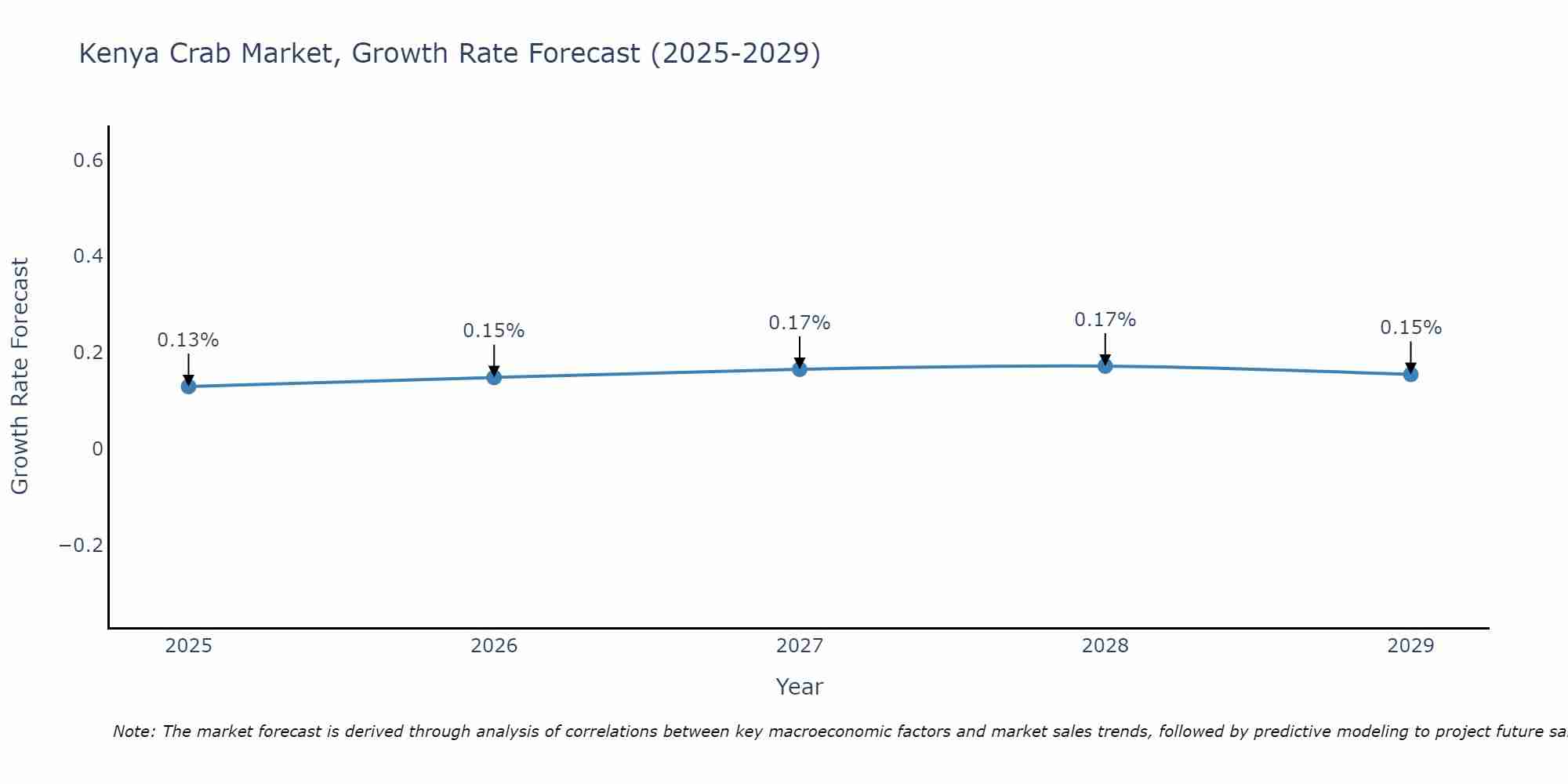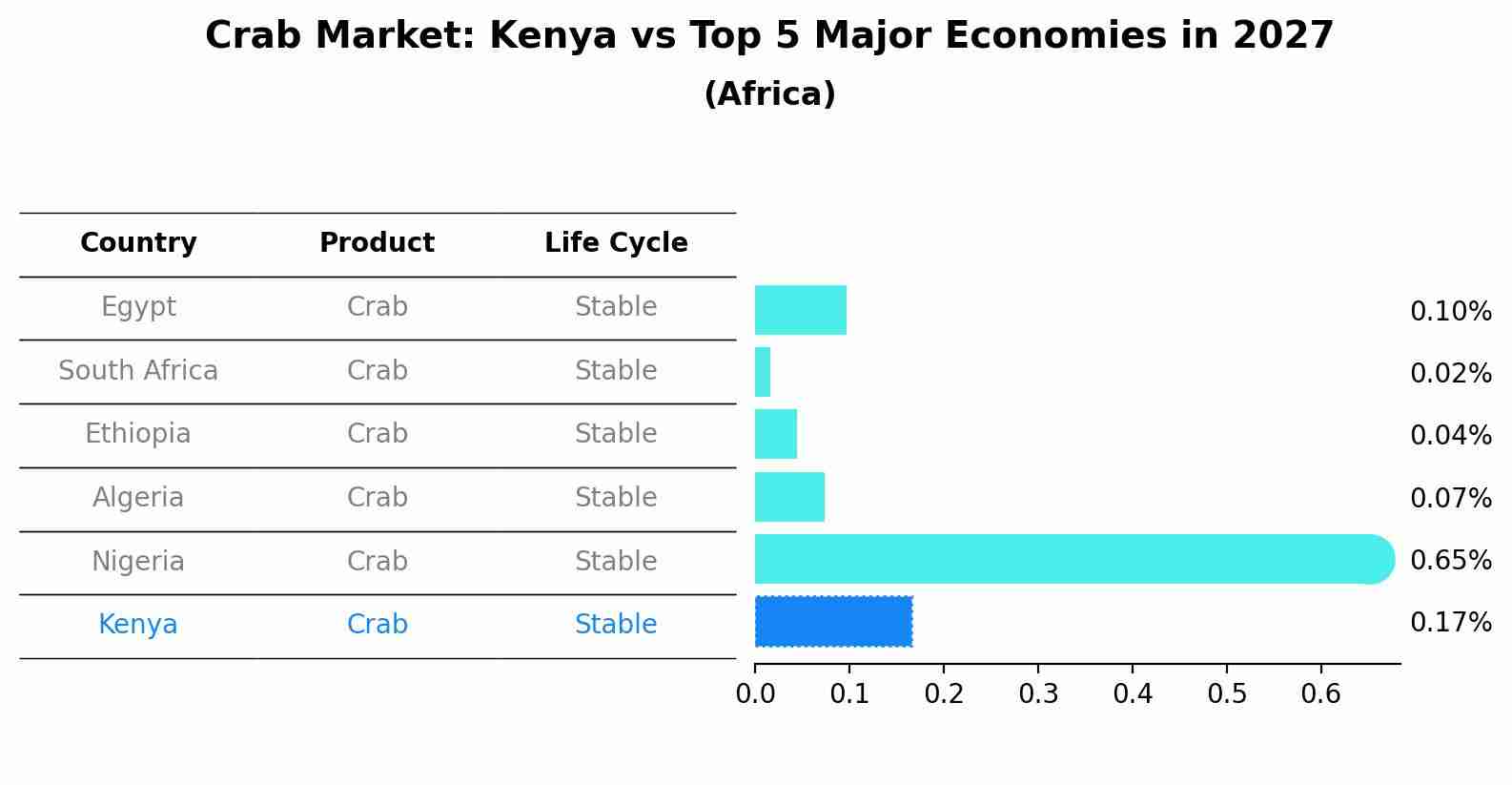Kenya Crab Market Outlook | Share, Forecast, Analysis, Growth, Revenue, Value, Trends, COVID-19 IMPACT, Companies, Size & Industry
| Product Code: ETC088869 | Publication Date: Jun 2021 | Updated Date: Jun 2025 | Product Type: Report | |
| Publisher: 6Wresearch | Author: Sachin Kumar Rai | No. of Pages: 70 | No. of Figures: 35 | No. of Tables: 5 |
Kenya Crab Market Size Growth Rate
The Kenya Crab Market is projected to witness mixed growth rate patterns during 2025 to 2029. Growth accelerates to 0.17% in 2028, following an initial rate of 0.13%, before easing to 0.15% at the end of the period.

Crab Market: Kenya vs Top 5 Major Economies in 2027 (Africa)
In the Africa region, the Crab market in Kenya is projected to expand at a stable growth rate of 0.17% by 2027. The largest economy is Egypt, followed by South Africa, Ethiopia, Algeria and Nigeria.

Kenya Crab Market Overview
The Kenya Crab Market is experiencing steady growth driven by increasing demand for seafood products domestically and internationally. The market primarily consists of both traditional crab fishermen as well as commercial crab farming operations along the coastal regions of Kenya. Blue swimming crabs are the most commonly harvested species in Kenya, prized for their sweet and tender meat. The market is also supported by a growing number of seafood processing and exporting companies that cater to both local consumers and overseas markets. Factors such as rising disposable incomes, changing consumer preferences towards healthy and sustainable food options, and advancements in seafood processing technologies are expected to further drive the growth of the Kenya Crab Market in the coming years.
Kenya Crab Market Trends
The Kenya Crab Market is experiencing several notable trends. One significant trend is the increasing demand for crab products both domestically and internationally, driven by the rising popularity of seafood consumption and a growing awareness of the health benefits of consuming crabs. Additionally, there is a shift towards sustainable and environmentally friendly practices in the crab fishing industry, with consumers showing a preference for ethically sourced and responsibly harvested crabs. Another trend is the emergence of value-added crab products, such as ready-to-eat crab meat and crab-based snacks, catering to the convenience-seeking consumer segment. The market is also seeing advancements in packaging and processing technologies to extend the shelf life of crab products and meet the demands of the modern consumer. Overall, the Kenya Crab Market is evolving to meet changing consumer preferences and global market dynamics.
Kenya Crab Market Challenges
In the Kenya crab market, some key challenges include inconsistent supply due to overfishing and illegal harvesting practices, inadequate infrastructure for storage and transportation leading to quality degradation, lack of standardized grading systems affecting pricing and market transparency, and limited access to market information for crab farmers and traders. Additionally, competition from imported seafood products poses a threat to the local crab industry, as well as fluctuations in global seafood prices impacting profitability. Addressing these challenges would require efforts to promote sustainable fishing practices, improve infrastructure and logistics, establish quality control measures, enhance market linkages for crab producers, and provide training and support to enhance competitiveness in the market.
Kenya Crab Market Investment Opportunities
The Kenya Crab Market presents promising investment opportunities due to increasing demand for crab meat both domestically and internationally. With Kenya`s long coastline and abundant marine resources, the country has the potential to become a significant player in the global crab market. Investors can explore opportunities in crab farming, processing, and exportation. Investing in modern crab farming techniques, sustainable harvesting practices, and efficient processing facilities can help capitalize on the growing demand for crab products. Additionally, partnering with local fishermen and communities can create a sustainable and socially responsible investment approach in the Kenya Crab Market. Overall, investing in the Kenya Crab Market offers potential for growth and profitability in the seafood industry.
Kenya Crab Market Government Policy
The government of Kenya has implemented various policies related to the crab market to ensure sustainability and regulate the industry. This includes licensing requirements for crab fishers, restrictions on minimum crab sizes that can be caught to protect juvenile populations, and designated fishing seasons to prevent overfishing. Additionally, the government has established marine protected areas to conserve crab habitats and promote breeding grounds. There are also regulations in place to control the export of crabs to maintain a balance between domestic consumption and international trade. Overall, these policies aim to promote the long-term viability of the Kenya crab market while safeguarding the marine ecosystem.
Kenya Crab Market Future Outlook
The future outlook for the Kenya Crab Market appears promising, driven by increasing demand for seafood products both domestically and internationally. The market is expected to grow steadily due to rising consumer preferences for healthy and sustainable protein sources. Additionally, improvements in fishing technologies and practices are likely to enhance the supply of crabs in the market. With Kenya`s extensive coastline and abundant marine resources, the country is well-positioned to capitalize on the growing global demand for seafood. However, challenges such as illegal fishing activities and environmental concerns may pose threats to the market`s growth. Overall, the Kenya Crab Market is expected to expand in the coming years, supported by favorable market dynamics and increasing awareness of the benefits of consuming seafood.
Key Highlights of the Report:
- Kenya Crab Market Outlook
- Market Size of Kenya Crab Market, 2021
- Forecast of Kenya Crab Market, 2027
- Historical Data and Forecast of Kenya Crab Revenues & Volume for the Period 2018 - 2027
- Kenya Crab Market Trend Evolution
- Kenya Crab Market Drivers and Challenges
- Kenya Crab Price Trends
- Kenya Crab Porter's Five Forces
- Kenya Crab Industry Life Cycle
- Historical Data and Forecast of Kenya Crab Market Revenues & Volume By Type for the Period 2018 - 2027
- Historical Data and Forecast of Kenya Crab Market Revenues & Volume By Blue Crab for the Period 2018 - 2027
- Historical Data and Forecast of Kenya Crab Market Revenues & Volume By Chinese Mitten Crab for the Period 2018 - 2027
- Historical Data and Forecast of Kenya Crab Market Revenues & Volume By Gazami Crab for the Period 2018 - 2027
- Historical Data and Forecast of Kenya Crab Market Revenues & Volume By Others for the Period 2018 - 2027
- Historical Data and Forecast of Kenya Crab Market Revenues & Volume By Form for the Period 2018 - 2027
- Historical Data and Forecast of Kenya Crab Market Revenues & Volume By Frozen for the Period 2018 - 2027
- Historical Data and Forecast of Kenya Crab Market Revenues & Volume By Canned for the Period 2018 - 2027
- Historical Data and Forecast of Kenya Crab Market Revenues & Volume By Others for the Period 2018 - 2027
- Kenya Crab Import Export Trade Statistics
- Market Opportunity Assessment By Type
- Market Opportunity Assessment By Form
- Kenya Crab Top Companies Market Share
- Kenya Crab Competitive Benchmarking By Technical and Operational Parameters
- Kenya Crab Company Profiles
- Kenya Crab Key Strategic Recommendations
Frequently Asked Questions About the Market Study (FAQs):
1 Executive Summary |
2 Introduction |
2.1 Key Highlights of the Report |
2.2 Report Description |
2.3 Market Scope & Segmentation |
2.4 Research Methodology |
2.5 Assumptions |
3 Kenya Crab Market Overview |
3.1 Kenya Country Macro Economic Indicators |
3.2 Kenya Crab Market Revenues & Volume, 2021 & 2027F |
3.3 Kenya Crab Market - Industry Life Cycle |
3.4 Kenya Crab Market - Porter's Five Forces |
3.5 Kenya Crab Market Revenues & Volume Share, By Type, 2021 & 2027F |
3.6 Kenya Crab Market Revenues & Volume Share, By Form, 2021 & 2027F |
4 Kenya Crab Market Dynamics |
4.1 Impact Analysis |
4.2 Market Drivers |
4.3 Market Restraints |
5 Kenya Crab Market Trends |
6 Kenya Crab Market, By Types |
6.1 Kenya Crab Market, By Type |
6.1.1 Overview and Analysis |
6.1.2 Kenya Crab Market Revenues & Volume, By Type, 2018 - 2027F |
6.1.3 Kenya Crab Market Revenues & Volume, By Blue Crab, 2018 - 2027F |
6.1.4 Kenya Crab Market Revenues & Volume, By Chinese Mitten Crab, 2018 - 2027F |
6.1.5 Kenya Crab Market Revenues & Volume, By Gazami Crab, 2018 - 2027F |
6.1.6 Kenya Crab Market Revenues & Volume, By Others, 2018 - 2027F |
6.2 Kenya Crab Market, By Form |
6.2.1 Overview and Analysis |
6.2.2 Kenya Crab Market Revenues & Volume, By Frozen, 2018 - 2027F |
6.2.3 Kenya Crab Market Revenues & Volume, By Canned, 2018 - 2027F |
6.2.4 Kenya Crab Market Revenues & Volume, By Others, 2018 - 2027F |
7 Kenya Crab Market Import-Export Trade Statistics |
7.1 Kenya Crab Market Export to Major Countries |
7.2 Kenya Crab Market Imports from Major Countries |
8 Kenya Crab Market Key Performance Indicators |
9 Kenya Crab Market - Opportunity Assessment |
9.1 Kenya Crab Market Opportunity Assessment, By Type, 2021 & 2027F |
9.2 Kenya Crab Market Opportunity Assessment, By Form, 2021 & 2027F |
10 Kenya Crab Market - Competitive Landscape |
10.1 Kenya Crab Market Revenue Share, By Companies, 2021 |
10.2 Kenya Crab Market Competitive Benchmarking, By Operating and Technical Parameters |
11 Company Profiles |
12 Recommendations |
13 Disclaimer |
- Single User License$ 1,995
- Department License$ 2,400
- Site License$ 3,120
- Global License$ 3,795
Search
Thought Leadership and Analyst Meet
Our Clients
Related Reports
- Afghanistan Apparel Market (2026-2032) | Growth, Outlook, Industry, Segmentation, Forecast, Size, Companies, Trends, Value, Share, Analysis & Revenue
- Canada Oil and Gas Market (2026-2032) | Share, Segmentation, Value, Industry, Trends, Forecast, Analysis, Size & Revenue, Growth, Competitive Landscape, Outlook, Companies
- Germany Breakfast Food Market (2026-2032) | Industry, Share, Growth, Size, Companies, Value, Analysis, Revenue, Trends, Forecast & Outlook
- Australia Briquette Market (2025-2031) | Growth, Size, Revenue, Forecast, Analysis, Trends, Value, Share, Industry & Companies
- Vietnam System Integrator Market (2025-2031) | Size, Companies, Analysis, Industry, Value, Forecast, Growth, Trends, Revenue & Share
- ASEAN and Thailand Brain Health Supplements Market (2025-2031) | Strategy, Consumer Insights, Analysis, Investment Trends, Opportunities, Growth, Size, Share, Industry, Revenue, Segments, Value, Segmentation, Supply, Forecast, Restraints, Outlook, Competition, Drivers, Trends, Demand, Pricing Analysis, Competitive, Strategic Insights, Companies, Challenges
- ASEAN Bearings Market (2025-2031) | Strategy, Consumer Insights, Analysis, Investment Trends, Opportunities, Growth, Size, Share, Industry, Revenue, Segments, Value, Segmentation, Supply, Forecast, Restraints, Outlook, Competition, Drivers, Trends, Demand, Pricing Analysis, Competitive, Strategic Insights, Companies, Challenges
- Europe Flooring Market (2025-2031) | Outlook, Share, Industry, Trends, Forecast, Companies, Revenue, Size, Analysis, Growth & Value
- Saudi Arabia Manlift Market (2025-2031) | Outlook, Size, Growth, Trends, Companies, Industry, Revenue, Value, Share, Forecast & Analysis
- Uganda Excavator, Crane, and Wheel Loaders Market (2025-2031) | Strategy, Consumer Insights, Analysis, Investment Trends, Opportunities, Growth, Size, Share, Industry, Revenue, Segments, Value, Segmentation, Supply, Forecast, Restraints, Outlook, Competition, Drivers, Trends, Demand, Pricing Analysis, Competitive, Strategic Insights, Companies, Challenges
Industry Events and Analyst Meet
Whitepaper
- Middle East & Africa Commercial Security Market Click here to view more.
- Middle East & Africa Fire Safety Systems & Equipment Market Click here to view more.
- GCC Drone Market Click here to view more.
- Middle East Lighting Fixture Market Click here to view more.
- GCC Physical & Perimeter Security Market Click here to view more.
6WResearch In News
- Doha a strategic location for EV manufacturing hub: IPA Qatar
- Demand for luxury TVs surging in the GCC, says Samsung
- Empowering Growth: The Thriving Journey of Bangladesh’s Cable Industry
- Demand for luxury TVs surging in the GCC, says Samsung
- Video call with a traditional healer? Once unthinkable, it’s now common in South Africa
- Intelligent Buildings To Smooth GCC’s Path To Net Zero


















